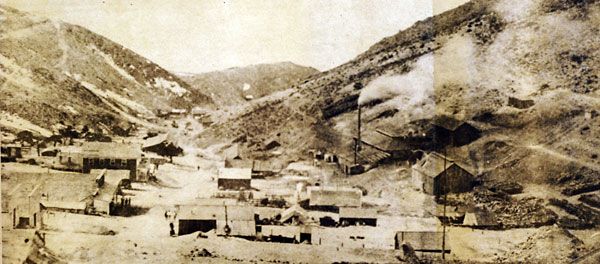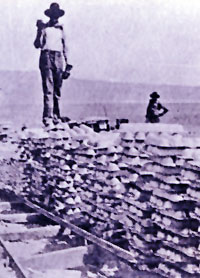|
 In the fall of 1861, a savvy French Canadian named
Remi Nadeau arrived in Los Angeles and ran into a well known local
businessman, named Prudent Beaudry. Mr. Nadeau asked Mr. Beaudry
for $600 which he quickly invested in a wagon and six mules so he
could start up a little freighting business.
In the fall of 1861, a savvy French Canadian named
Remi Nadeau arrived in Los Angeles and ran into a well known local
businessman, named Prudent Beaudry. Mr. Nadeau asked Mr. Beaudry
for $600 which he quickly invested in a wagon and six mules so he
could start up a little freighting business.
Remi
Nadeauís first freight route covered nearly 700 miles and thirty
five days across the Great Basin between Salt Lake City, and Utah,
to Los Angeles. By 1864, he and others like him were teaming 1,100
miles and sixty days to the camps of Bannock and Virginia City,
Montana. By 1868, the joining of the Union Pacific and Central
Pacific Railroads, threatened the freight wagon business.
In
December of 1868, Nadeau's freight wagons were rolling with full
loads of 18 inch,85 pound silver lead ingots headed down to Los
Angeles from the Inyo Mountain mining camp of Cerro Gordo. The
wagons would then make the return 230 mile trip along the Bullion
Trail to Cerro Gordo with wine, brandy, fruits and nuts, potatoes,
corn and other necessities.
By 1871,
with more than 2,246 tons of bullion coming out of the high desert
mountain top, the Los Angeles based News was proclaiming
that Nadeau "has given employment to more men, and purchased more
produce, and introduced more trade to Los Angeles than any other
five men in this city."
 |
|
View of
Cerro Gordo taken between 1879 and 1887. View is looking
down canyon to Owens Lake.
Victor
Beaudry's smelter is at the right of the photo.
(Photo: Robert C. Likes collection) |
With the
expiration of Remi Nadeau's Cerro Gordo freighting contract in
December of 1871, the business went to James Brady, the
superintendent of the Owens Lake Company smelter. Bradyís furnace
and the launch of the Bessie Brady steamer six months later,
controlled the entire Cerro Gordo bullion. The little steamer
carrying ingots across the Owens Lake saved three days wagon travel,
but the wagon subcontractor hired by Brady couldnít haul the silver
bars from the lakeside fast enough. Although others would try their
hand at moving the bullion, Nadeau eventually, wound up with the
contract once again.
 |
|
Although this photo was made in 1909, similar sized bars
of Cerro Gordo silver-lead bullion piled up on the south
end of Owens Lake after Nadeau's first freighting
contract expired. |
Nadeau
joined hands with Mortimer Belshaw and Victor Beaudry of the Cerro
Gordo mines, to form the Cerro Gordo Freighting Company. As his
empire grew, he had eighty teams, each consisting of fourteen mules
and three high sided wagons, carrying freight from Cerro Gordo and
other mining camps to Los Angeles and back again. He also built
stations at 13 to 21 mile intervals along the trail, providing
stopovers for tired freighters and their worn mules. Remi Nadeau was
the premier freight mogul for the Eastern Sierra trade for the next
nine years.
The
jingle bells of the Cerro Gordo Freight Company's mules, were
eventually silenced by the thunderous sounds of the Iron Horses, as
rails were completed from Mojave to Los Angeles. Remi Nadeau
turned his interests elsewhere. In November, 1882, the famous
freight wagons delivered mill machinery for the last time to
Providence near Mitchell caverns in the Eastern Mojave, and the
Bonanza King Mine. The following year, mule teams, jingle bells,
wagons and all were sold to Nadeau's wagon boss who still managed to
find freighting jobs between Calico and Daggett.
In 1880,
aware that it was a changing age, Nadeau began importing sugar beet
seeds, and invested in a $100,000 sugar beet factory. He owned
several hundred acres of land east of Florence, which were now
devoted to the sugar beet venture. Many of the farmers in Los
Angeles County made use of the seed distributed by Nadeau. By the
fall of 1880, 1100 acres had been planted on Nadeau's farms, as
well as others. At the mouth of Ballona Creek, he planted another
2800 acres of sugar beet. Sadly, the sugar refinery failed to work.
Nadeauís friend, Harris Newmark wrote, "bad at best, and the more
sugar one put in coffee, the blacker the coffee became."
Nadeau
decided to turn his sweet failure to success, and began purchasing
and planting a million cuttings of wine grapes. In November of 1881,
Nadeau's sugar beet fields turned into vineyards of mission,
zinfandel, and Charbonneau grapes. Less than three years later, he
had 2,000,000 grape cuttings on his 3,600 acres east of Florence.
This was proclaimed to be the largest vineyard in the world.
Successes
in winery, led Nadeau to try his hand at growing barley. 31,000
acres in what is now Inglewood became the site of the largest barley
crop in the world. The infamous droughts of Southern California,
however, soon put an end to Remi Nadeau's ambitions as a barley
king.
Even
before his freighting business was gone, in 1878, Nadeau had
purchased some land at the southwest corner of First and Spring
Streets in Los Angeles for $20,000. The property contained an old
adobe with a horse corral a block in the distance from it. The Plaza
was still the place for thriving businesses in the late 1870's, and
Nadeau was laughed at for purchasing property so far south. Friend,
Harris Newmark, told him he was "crazy". With money from a windfall
in barley speculation in 1882, Nadeau's designs were on a 1500 seat
showplace theater for Los Angeles, much like the great theaters of
San Francisco. He even hired an architect to study the San Francisco
theaters and draw up plans.
 |
| The
Nadeau Hotel offered first rate accommodations in early
Los Angeles. The Los Angeles Times building now
occupies the location near present day Los Angeles City
Hall. |
Plans for
an elaborate theater somehow changed to a four-story business block,
with a passenger elevator, the first of its kind in Los Angeles. The
old adobe on the Nadeau property was torn down and the ground
preparations began. Los Angeles gossiped of "Nadeau's Folly".
Nadeau's folly, and original plans for stores, professional offices
and private residences, however, turned into the Nadeau Hotel, when
a local hotelier leased the entire building in May 1886. On July
5th, the hotel opened with a magnificent banquet and ball. Through
the turn of the century, Nadeau's hotel was the place to be for Los
Angelinos. The Nadeau Hotel stood at the site of the present day
Los Angeles Times building.
The following letter describes a visit to old Los Angeles and the
Nadeau Hotel in 1888:
Los Angeles Cal
Monday 17th Septr 1888
Nadeau Hotel
My dear Son
Yesterday morning when we left San Francisco the
weather was delightfully cool and our journey was pleasant up to
3 pm when we got into hot weather and dust, and we have had it
hot ever since.
The journey was very uninteresting - a repetition of the
Prairie from Omaha to California. We passed through as great
deal of the Alkali [desert] too, this morning.
The town looks quite lively, being dressed in flags and
arches. The Odd Fellows are having a picnic here this week. I
believe they are coming from all parts of the U.S. Do not know
whether it is a convention or a conclave, but I have as above
called it a picnic.
This seems to be quite a thriving City. Has horse cars, cable
cars, and all the modern improvements in lighting. But it is a
long journey to get here. Hotel very good.
Have not yet seen the theatre. I do anticipate having
rehearsals this week, so will be able to tell you more about the
place in my next letter.
No more at present, but love and Kisses from your loving
Mother.
The
ensuing years, brought declining fortunes and messy private affairs
for Remi Nadeau. The great boom of the 1880's did manage to bring
declining property values back up long enough for him to secure
$225,000 in funds through a new mortgage on the Nadeau Hotel. This
paid off debts he had accrued from unsuccessful sugar beet and
barley farming, but could not buy him his health. In the middle of
January, 1887, Remi Nadeau succumbed to complications from Bright's
Disease.
Bibliography
The City Makers
by Remi Nadeau
Trans Anglo Books
From This Mountain, Cerro Gordo
by Robert C. Likes &
Glenn R. Day
Chalfant Press
The Silver Seekers
by Remi Nadeau
Crest Publishing
http://home.comcast.net/~m.chitty/losangeles.htm#nadeau
http://www.csulb.edu/~odinthor/socal3.html
|
